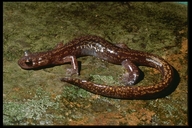|
Description
No lungs. Vomerine teeth in two arch-shaped continuous series; premaxillary fontanelle large. Parotoids developed moderately. Costal grooves well-developed. Tail long, cylindrical at the base and slightly compressed at the end, slightly longer than the body with head. Toes five. Coloration brown or brown-greyish, with dark points and obscure dorsal golden or brownish band which may be divided into large spots. Males have a relatively shorter tail and relatively longer forelegs than females, and a lateral fold on the hind leg between the 5th toe and tibia. Male's vent is longer and more swollen, tail tip acute in female and rounded in male. Completely developed larvae with distinct, acute, blackish claws; larvae of rheophilous type. Distribution and Habitat
Country distribution from AmphibiaWeb's database: Russian Federation
The species is distributed in the Russian Far East, Eastern China, and Korea. Presently confirmed northernmost records are the Sikhote-Alinskii Nature Reserve and the mountains in the area of the Kamen-Rybolov Settlement at Khanka Lake, both in Russia. The borders of the northern and north-western parts of the range are not yet definitely known. Evidently, the range extends through the Sikhote-Alin mountains near 45ºN or slightly farther north. The north-eastern part of the species' range, including Sikhote-Alin, is separated from the rest of the range by the valleys of the Ilistaya and Razdolnaya rivers positioned between Lake Khanka and the Pacific Ocean. The species inhabits conifer and mixed cedar pine-broad leafed forests, where it occurs only in surroundings of small mountain streams and, rarely, clean cnd cool lakes. High humidity of stream banks, dense vegetation, cool water (+6-+11ºC), thick layer of pebbles, and the presence of unfrozen pools are necessary for existence of the populations. Life History, Abundance, Activity, and Special Behaviors
In suitable sites, the population density may reach up to 2-5 adults per 10 m2, but as rule the abundance is relatively low. In general the species seems to be more abundant in the southern part of its geographical distribution. Adults are mostly aquatic in spring, early summer and mid-autumn, and mostly terrestrial from the late summer to early autumn. Hibernation probably takes place from October to April. The first active individuals appear from the end of April to the beginning of May. Data on the reproduction of the Long-Tailed Clawed Salamander in nature are very scarce and rather hypothetical. Only once has a group of 19 clutches been found in Lazo District, Russian Far East, 9 August 1989, below a large rock in a stream. It is supposed that reproduction typically occurs in the bottom pebble layer in the underground springs of the streams. The males possess well-developed folds on the hind legs and females have large oocytes from April to mid-July and from August to September. Adults with these characters "disappear" in July, probably for spawning. The smalles known larvae, raging Tl from 34-39 mm, are most numerous in July, when they probably leave underground clutch habitats. The smallest and older larvae prefer to stay in stream pools, avoiding the mainstream. The larvae probably hibernate several times before metamorphosis. Larvae forage mainly upon brook gammarids and larval insects. Adults, in addition, prey on terrestrial insects, millipedes, etc. Main natural enemies of larval salamanders are fishes. This is the main reason why the larvae live mainly in small tributaries but not large streams and rivers. Trends and Threats
Anthropogenic pressure on populations appears to be generally low. Tree felling in stream headwaters seem to constitute the main threat. For example, a lower abundance of the species in the territory newly joined to the Ussuriiskii Nature Reserve, Primorye Region, Russia, is attributed to tree felling there 30-40 years earlier. Digging of gravel on the streams for economic purposes may also compose a threat for the salamander populations. Relation to Humans
Cases of collecting of the Long-Tailed salamander are rare. Local people usually do not know this animal. Sometimes fishermen use the larvae as a bait in fishing. Comments
The salamander deserves inclusion in the IUCN Red List under the category DD.
References
Bannikov, A. G., Darevsky, I. S. and Rustamov, A. K. (1971). Zemnovodnye i Presmykayushchienya SSSR [Amphibians and Reptiles of the USSR]. Izdatelistvo Misl, Moscow.
Bannikov, A. G., Darevsky, I. S., Ishchenko, V. G., Rustamov, A. K., and Szczerbak, N. N. (1977). Opredelitel Zemnovodnykh i Presmykayushchikhsya Fauny SSSR [Guide to Amphibians and Reptiles of the USSR Fauna]. Prosveshchenie, Moscow.
Emelianov, A. A (1947). ''To the biology of the Lungless Triton (Onychodactylus fischeri).'' Zoologichesky Zhurnal, 46(1), 65-70.
Kuzmin, S. L (1995). The Clawed Salamanders of Asia (Genus Onychodactylus). Westarp Wissenschaften, Magdeburg.
Kuzmin, S. L. (1995). Die Amphibien Russlands und angrenzender Gebiete. Westarp Wissenschaften, Magdeburg.
Kuzmin, S. L. (1999). The Amphibians of the Former Soviet Union. Pensoft, Sofia-Moscow.
Nikolsky, A. M (1936). Fauna of Russia and Adjacent Countries: Amphibians (English translation of Nikolsky, 1918, Faune de la Russie et des Pays limitrophes. Amphibiens. Académie Russe des Sciences, Petrograd, USSR). Israel Program for Scientific Translations, Jerusalem.
Regel, E. D. and Epstein, S. M. (1977). ''The external morphology of larvae of Onychodactylus fischeri Boulenger (Hynobiidae).'' Zoologichesky Zhurnal, 56(6), 901-912.
Terent'ev, P. V. and Chernov, S. A (1965). Key to Amphibians and Reptiles [of the USSR]. Israel Program for Scientific Translations, Jerusalem.
Ye, C., Fei, L., and Hu, S. Q. (1993). Rare and Economic Amphibians of China. Sichuan Publishing House of Science and Technology, Chengdu.
Originally submitted by: Sergius L. Kuzmin (first posted 1999-09-13)
Edited by: Kellie Whittaker (2007-12-06)Species Account Citation: AmphibiaWeb 2007 Onychodactylus fischeri: Long-Tailed Clawed Salamander <https://amphibiaweb.org/species/3905> University of California, Berkeley, CA, USA. Accessed May 29, 2025.
Feedback or comments about this page.
Citation: AmphibiaWeb. 2025. <https://amphibiaweb.org> University of California, Berkeley, CA, USA. Accessed 29 May 2025.
AmphibiaWeb's policy on data use.
|




 Raffaëlli Account
Raffaëlli Account Map of Life
Map of Life